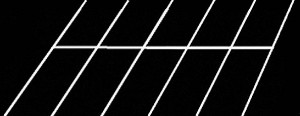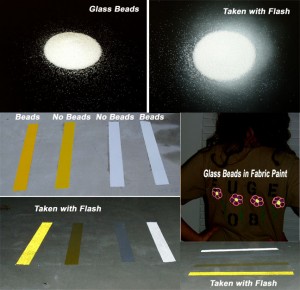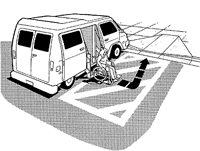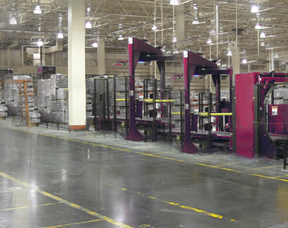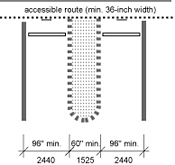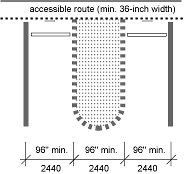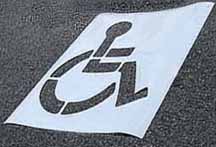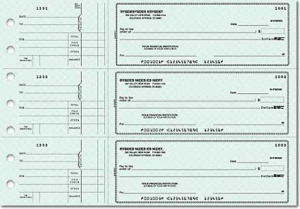The task of pricing or bidding parking lot striping jobs is sometimes overwhelming for new striping or sealcoating companies. It is normal to be apprehensive of things you have never done, however, the process of estimating a parking lot striping or sealcoating job does not have to be complicated. The best way to make this process manageable is to break the task down into smaller sections. Using our STRIPE-CALC or STRIPE-INVOICE spreadsheet will also help make the process much simpler.
When I price a parking lot my goal is to receive about 20 cents per linear foot of four inch striping, sixty cents per linear foot for the curbing that runs along the front of many shopping centers, and $50 – $60 per hour plus materials for logos and markings that can’t be calculated by the linear foot. An example of these would be arrows, light bases, bumpers, handicap logos, etc… Remember that your prices may be higher or lower depending on your market.
When I arrive at a location to do a bid the first thing I do is count and record the number of 4″ lines in the lot. These are the parking stall lines that make up the bulk of the striping that you will be doing. There is no need to measure every parking space line. This would take you all day. Simply count the number of car spaces. If there is a line separating cars that park nose to nose like in the picture below that will be calculated separately. One thing to note is that in the picture below there are spaces for 10 cars. However, if you count the lines there are 12. So if you have a block of spaces holding 100 nose to nose cars you will in most cases have 102 lines for that block because you have to have two lines at the end to start the block. If you don’t count the extra two that is fine but if you had 20 blocks of spaces in a large parking lot you would be giving away $160. After I count up the 4″ lines I multiply the number of spaces by $4 which is a shortcut for adding up all the linear feet and multiplying by 20 cents. Then I calculate the linear footage of all the other 4″ lines in the parking lot and multiply by 20 cents. This will include the centerline between nose to nose parking, firelane striping, the lines down the middle of the road and any hatch areas. You should now have a total for all of the 4″ lines in the lot.
After you have done this you are going to want to calculate pricing for the other markings in the parking lot such as logos, stop bars, arrows, light bases and bumpers. I normally charge $15 – $25 for a basic arrow depending on the size, 60 cents per linear foot for curbing, $10 per car stop (parking lot bumper), and $20 per light base. You will need to make a list of typical items and pre price them. A way to price odd items like this is to take the amount of time it will take you to paint the item then multiply that a $ rate per minute. (I use $1 per minute or $60 per hour) Then add the cost of your materials times two to that number. For example, if it will take 20 minutes for you to paint a light pole base and $2 in paint you would charge $20 plus $4 for a total of $24 per base.
For potholes that I can patch with bagged asphalt I usually price the same as I do miscellaneous items. I double the cost of my asphalt and then estimate the time it will take to apply it, multiply that by a dollar per minute, and add those number together.
Here is an example of a simple parking lot.
120 spaces – $480
400 feet of centerline – $80
400 feet of other 4″ – $80
300 feet of curbing – $180
6 medium arrows – $90
2 – 12″ x 20 stop bars – $48 (1.20 per linear foot x 40)
2 pot holes – $40 (20 minutes times $1 plus ($10 x 2) for materials)
Total – $998
To keep things simple, set a per linear foot price for 4″ and other width striping and apply that to as much of the lot as possible. Then set your prices for odds and ends. As previously outlined, use the double the materials plus $50-$60 per hour approach for these miscellaneous items. When you price by the linear foot, keep in mind that the hourly rate, materials etc.. are all in that per linear foot price. You will not need to calculate those items in again.
There are other ways to price but this is the method that I find the most logical and straight forward. I hope this information is useful to you.
I have a spreadsheet pricing program available at the following link. CLICK HERE.
To see more of our parking lot striping articles CLICK HERE.
Steven Cole (Economics, MBA – University of West Florida, Business & Innovation – Stanford University) 30 years experience in the parking lot striping business. Expert in reflective visibility solutions.
